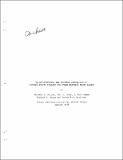| dc.contributor.author | Najjar, Kenneth F. | |
| dc.contributor.author | Shaw, John J. | |
| dc.contributor.author | Adams, E. Eric | |
| dc.contributor.author | Jirka, Gerhard H. | |
| dc.contributor.author | Harleman, Donald | |
| dc.date.accessioned | 2006-12-19T16:31:36Z | |
| dc.date.available | 2006-12-19T16:31:36Z | |
| dc.date.issued | 1979-01 | |
| dc.identifier.other | 09555116 | |
| dc.identifier.uri | http://hdl.handle.net/1721.1/35208 | |
| dc.description | Originally presented as a thesis (M.S.), M.I.T., Dept. of Civil Engineering, 1978, by Kenneth F. Najjar. | en |
| dc.description.abstract | The selection of waste heat rejection systems for steam-electric
power plants involves a trade-off among environmental, energy and water
conservation, and economic factors. This study compares four general
types of cooling systems on the basis of these factors. The cooling
systems chosen for study are: once-through systems including surface
canals and submerged multiport diffusers; shallow closed cycle cooling
ponds; mechanical and natural draft evaporative cooling towers; and
mechanical draft dry towers.
The cooling system comparison involves, first, an optimization of
each cooling system and then a comparison among optimal systems.
Comparison is made for an 800 MWe fossil unit and a 1200 MWe nuclear unit
located at a hypothetical midwestern river site. A set of models has
been developed to optimize the components of each cooling system based
on the local meteorological and hydrological conditions at the site in
accordance with a fixed demand, scalable plant concept. This concept
allows one to compare the costs of producing the same net power from
each plant/cooling system. Base case economic parameters were used to
evaluate the optimum system for each of the four general cooling systems
followed by a sensitivity study for each parameter. Comparison of energy
and water consumption follows from the results of the performance model,
while comparison of environmental impacts is mostly qualitative. Some
quantitative modelling was performed for the environmental effects of
thermal discharges from once-through systems, fogging from wet cooling
towers and water consumption from the ponds, wet towers and once-through.
The results of the optimization models of each of the systems are
compared on the basis of: performance - discrete distributions of
environmental conditions and transient simulation; economics - using base
case scenarios and sensitivity values to arrive at costs expressed in
terms of production costs, annualized costs and present value costs;
energy and water consumption; and environmental effects. The once-through
systems were found to be the least expensive of the four systems, the
most energy efficient, but potentially the most environmentally damaging.
On the other extreme, dry cooling towers are the most environmentally
sound while being the most expensive and least energy efficient. Finally,
the results of the economic optimization are compared with results from
previous comparative studies. | en |
| dc.format.extent | 8009419 bytes | |
| dc.format.mimetype | application/pdf | |
| dc.language.iso | en_US | en |
| dc.publisher | MIT Energy Laboratory | en |
| dc.relation.ispartofseries | MIT-EL | en |
| dc.relation.ispartofseries | 79-037 | en |
| dc.subject | Steam power plants |x Cooling |x Environmental aspects. | en |
| dc.subject | Steam power plants |x Cooling |x Economic aspects. | en |
| dc.subject | Steam power plants |x Cooling |x Mathematical models. | en |
| dc.subject | Waste heat. | en |
| dc.title | An environmental and economic comparison of cooling system designs for steam-electric power plants | en |
| dc.type | Technical Report | en |
